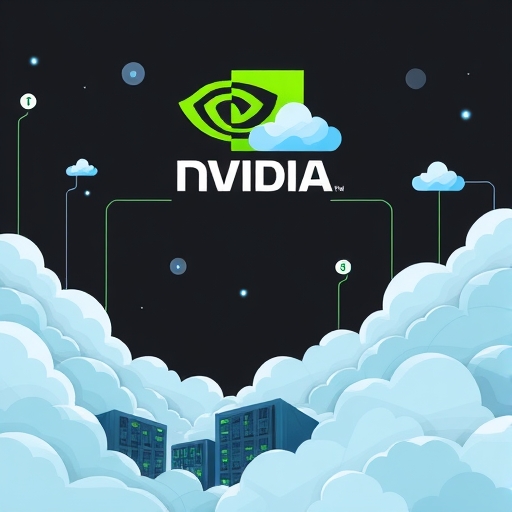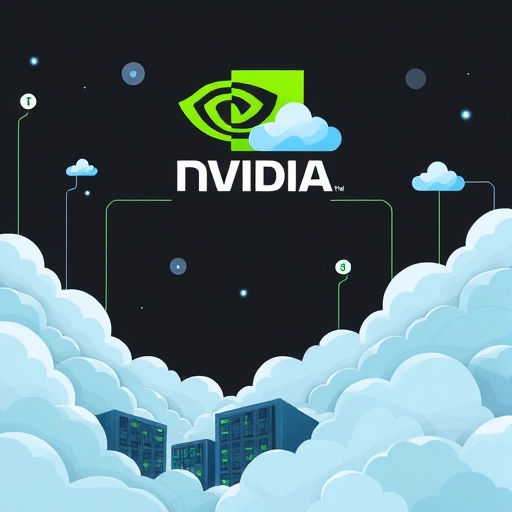Navigating the AI Frontier: Understanding Nvidia’s Unseen Pillars of Growth
In the rapidly accelerating world of artificial intelligence (AI), one company stands as an undeniable titan: Nvidia. Its graphics processing units (GPUs) have become the indispensable backbone of global AI infrastructure, powering everything from sophisticated large language models (LLMs) to autonomous driving systems. While Nvidia, as a public company, maintains a degree of discretion regarding its precise customer roster, careful analysis of public filings, expert insights, and the capital expenditure patterns of tech giants reveals a fascinating truth: a select group of formidable tech titans and ambitious AI startups are collectively channeling staggering sums into Nvidia’s advanced hardware. This unprecedented demand has fueled Nvidia’s meteoric rise, yet it simultaneously introduces a noteworthy concentration risk that every discerning investor must understand. Are you prepared to delve into the hidden dynamics driving this AI revolution and discover the powerful entities silently shaping Nvidia’s destiny?
- Key Players: Nvidia is primarily supported by large tech firms and innovative AI startups.
- Growth Dynamics: Rapid advancements in AI technology are causing exponential increases in demand for Nvidia GPUs.
- Investment Patterns: The concentration of investments from major clients signals potential risks for Nvidia’s future revenue streams.
The Hidden Architects: Unmasking Nvidia’s Core Clientele
Nvidia, with its dominant position in the AI chip market, does not publicly disclose the names of its largest customers. This is a common practice among B2B companies to protect competitive intelligence and client relationships. However, in the interconnected world of technology and finance, shrewd analysts and observant investors can piece together a compelling picture using various public data points. We can deduce, with a high degree of certainty, that the most significant purchasers of Nvidia’s cutting-edge GPUs are the very companies at the forefront of the AI race. Think about the global cloud providers, the pioneers in generative AI, and the innovators in areas like autonomous vehicles. These are the entities that require immense computational power to train and deploy their complex AI models, making them natural partners for Nvidia’s high-performance silicon. Do you ever wonder which corporations quietly hold the keys to Nvidia’s astounding revenue streams?

While official lists remain elusive, the collective intelligence from market research firms, investment bank reports, and even direct mentions by the customers themselves during earnings calls, points to a clear cohort. The names frequently emerging are those that dominate the digital landscape: Amazon, Microsoft, Alphabet (Google’s parent company), Meta Platforms, Oracle, and Tesla. Beyond these established giants, a new wave of well-funded AI startups like OpenAI, Anthropic, and Elon Musk’s xAI are also significant buyers, building their foundational AI models on Nvidia’s architecture. This convergence of demand from both entrenched tech leaders and agile innovators paints a vivid picture of the sheer scale of investment flowing into AI, and consequently, into Nvidia.
| Company | Focus Area |
|---|---|
| Amazon | Cloud Services (AWS) |
| Microsoft | Azure Cloud & AI Integration |
| Alphabet | Google Cloud & AI Development |
| Meta Platforms | Social Media & Metaverse AI |
| Oracle | Enterprise Software & Cloud |
| Tesla | Autonomous Vehicles |
Microsoft’s Staggering Contribution: A Deep Dive
Among the pantheon of Nvidia’s top customers, one name consistently surfaces as potentially the most pivotal: Microsoft. According to detailed analyses from reputable financial institutions like UBS, and corroborating data from Bloomberg, Microsoft is estimated to be Nvidia’s single largest customer. Some reports even suggest that Microsoft’s purchases alone could account for a substantial portion of Nvidia’s revenue, possibly in the range of 15% to 19%. This level of concentration with a single client, while testament to the strategic partnership, also highlights a unique aspect of Nvidia’s business model. Why would Microsoft be such a voracious buyer of Nvidia’s GPUs?
The answer lies in Microsoft’s aggressive push into AI, particularly through its Azure cloud computing platform and its deep integration with OpenAI, the developer of ChatGPT. Building out the vast infrastructure required to support millions of users accessing AI services, as well as the intensive training of next-generation LLMs, necessitates an unprecedented quantity of high-performance GPUs. Microsoft’s significant capital expenditures (capex) dedicated to its cloud services and AI initiatives directly translate into massive orders for Nvidia’s chips. Consider the scale: Microsoft projects spending over $80 billion by June 2025 on its cloud and AI infrastructure. A substantial portion of this colossal investment is inevitably channeled into acquiring Nvidia’s top-tier GPUs, forming the very foundation upon which their AI aspirations are built. This symbiotic relationship underscores how deeply intertwined the fortunes of these tech giants have become in the age of AI.
Amazon & Google: Billions Poured into Cloud AI Infrastructure
Beyond Microsoft, two other hyperscalers, Amazon and Alphabet (Google), represent critical pillars of Nvidia’s revenue. These companies are not merely adopting AI; they are fundamentally reshaping their entire cloud computing infrastructure to prioritize AI workloads. For Amazon, its Amazon Web Services (AWS) division is a powerhouse that serves millions of businesses globally, providing the computational resources for a wide array of applications, increasingly including AI development and deployment. To maintain its competitive edge and serve burgeoning AI demand, Amazon is projected to invest up to $105 billion by 2025 in its infrastructure, with a significant allocation towards AI data centers and Nvidia GPUs. This massive capex fuels the expansion of AWS’s AI services, offering crucial compute power to startups and enterprises alike who cannot afford their own vast GPU clusters.

Similarly, Alphabet, through its Google Cloud Platform, is making enormous strides in AI. Having pioneered many foundational AI technologies, Google is now pouring resources into scaling its AI capabilities to meet the demands of its own products like Gemini, and to support external developers via Google Cloud. Alphabet plans to invest an estimated $75 billion in calendar year 2025 into its global infrastructure, a substantial portion of which is dedicated to equipping its data centers with the necessary AI hardware. These investments by Amazon and Alphabet are not just about keeping pace; they are about preparing for an AI-driven future where computational power is the new currency. They represent a relentless, multi-year spending spree that directly benefits Nvidia, cementing its position at the core of the global cloud AI ecosystem. As an investor, do you grasp the sheer scale of these investments and their long-term implications for Nvidia?
Meta & Oracle: Expanding Their AI Footprint
The AI arms race extends beyond the traditional cloud giants, encompassing social media behemoths and enterprise software leaders. Meta Platforms, the parent company of Facebook, Instagram, and WhatsApp, is making an aggressive pivot towards AI, recognizing its strategic importance for everything from content recommendation algorithms to their ambitious metaverse initiatives. To achieve its AI goals, Meta is committing staggering amounts of capital, with projections suggesting investments of up to $72 billion in 2025. This monumental outlay is specifically earmarked for building out Meta’s AI-focused data centers, housing tens of thousands of Nvidia’s most advanced GPUs. Meta’s strategy involves not only leveraging AI for its existing products but also investing heavily in the foundational research and development of new AI models, requiring immense computational horsepower that only Nvidia can reliably deliver at scale.
Even enterprise software giant Oracle is joining the AI infrastructure spending spree. While traditionally known for databases and enterprise applications, Oracle has rapidly expanded its cloud offerings and is now investing heavily in AI. The company anticipates spending over $25 billion in fiscal year 2026, primarily to expand its Oracle Cloud Infrastructure (OCI) and enhance its AI capabilities. Oracle’s approach often involves partnering with AI startups and offering specialized cloud environments for AI development, which necessitates a robust supply of high-performance GPUs. These strategic investments from Meta and Oracle highlight the pervasive nature of AI adoption across diverse industries, each contributing significantly to the demand for Nvidia’s foundational technology. Are you surprised by the breadth of companies now investing so heavily in AI infrastructure?
| Company | Projected Investment |
|---|---|
| Meta Platforms | $72 billion (2025) |
| Oracle | $25 billion (FY 2026) |
Tesla, OpenAI, & Emerging AI Powerhouses: Driving Specialized Demand
Beyond the behemoths of cloud and social media, a new wave of specialized AI companies and innovative corporations are also emerging as significant consumers of Nvidia’s GPUs, driving demand for very specific and demanding AI workloads. Tesla, for instance, known primarily for its electric vehicles, is simultaneously a leader in AI due to its extensive work in autonomous driving. Training its self-driving software and advanced neural networks requires immense compute power. Tesla has already deployed massive Nvidia GPU clusters, reportedly installing 35,000 H100 GPUs for its AI infrastructure in 2024 alone, representing an investment exceeding $11 billion. This demonstrates how even non-traditional tech companies are becoming major GPU buyers to power their AI-centric products and services.
Furthermore, leading AI research labs and startups like OpenAI, Anthropic, and xAI are at the vanguard of developing frontier AI models, particularly large language models. These organizations are engaged in highly compute-intensive tasks, from pre-training multi-trillion parameter models to fine-tuning and inference for millions of users. Their entire business model hinges on access to massive GPU clusters, making them crucial, albeit often undisclosed, customers for Nvidia. These companies often secure large, multi-year commitments for Nvidia’s latest hardware, ensuring they have the computational muscle to stay ahead in the rapidly evolving AI landscape. Their specialized demands for high-density, high-performance computing represent a potent and growing segment of Nvidia’s customer base, emphasizing the diverse applications of AI and the foundational role of Nvidia’s technology.
Nvidia’s Technological Zenith: From Hopper to Rubin and Beyond
Nvidia’s ability to command such high prices and attract such enormous capital expenditures from its customers stems directly from its unparalleled technological leadership. The company has consistently pushed the boundaries of what’s possible with GPU architecture, creating generations of chips that deliver exponential performance improvements. The current workhorse for AI workloads has been the Hopper architecture, embodied by the highly sought-after H100 GPU. This chip has been the engine behind the generative AI boom, enabling the training and deployment of the most advanced AI models to date. But Nvidia is not resting on its laurels; its innovation pipeline is aggressive and relentless.

The introduction of the new Blackwell architecture, with its flagship GB200 Grace Blackwell Superchip, represents a monumental leap forward. Nvidia claims that the Blackwell architecture can deliver up to 50 times more performance than its Hopper predecessor for certain AI inference workloads, and significantly accelerate AI model training. This unprecedented performance allows companies to train larger models faster and deploy more complex AI applications with greater efficiency. Looking even further ahead, Nvidia has already unveiled its next-generation platform, codenamed Rubin, promising another significant generational leap. The Rubin platform is projected to offer an astonishing 165 times the performance of Hopper for AI inference. This continuous innovation, driven by the escalating demands of increasingly complex AI models—especially “reasoning models” which require 100 to 1,000 times more computing power—ensures a sustained, almost insatiable demand for Nvidia’s latest and greatest chips. It’s a testament to their engineering prowess that they remain so far ahead of the curve. As an aspiring investor, do you appreciate the importance of technological leadership in a rapidly evolving market?
The Trillion-Dollar Vision: Jensen Huang’s AI Data Center Forecast
Nvidia’s CEO, Jensen Huang, is not just a technology visionary; he’s also a keen observer of market trends. His forecasts for the future of AI data center spending underscore the long-term, massive market opportunity that underpins Nvidia’s growth trajectory. Huang has boldly predicted that global spending on AI data centers will exceed $1 trillion by 2028. This isn’t just an ambitious projection; it’s a reflection of the fundamental shift occurring in global computing infrastructure. Traditionally, data centers were built for general-purpose computing; now, they are being fundamentally redesigned and optimized for AI workloads, often referred to as “AI factories.”
This “trillion-dollar vision” signifies that the current wave of capital expenditures by major tech companies is not a temporary surge, but rather the beginning of a sustained, multi-year investment cycle. The demand for training and deploying ever-larger and more sophisticated AI models, coupled with the need for continuous upgrades to achieve higher performance and energy efficiency, will keep the demand for advanced GPUs robust. Jensen Huang envisions a future where AI data centers are as ubiquitous and critical as traditional power grids, serving as the computational engines of the modern economy. For investors looking at Nvidia, this long-term forecast provides a compelling narrative for sustained revenue growth and market dominance, assuming the company can maintain its technological lead. Can you envision a world where AI data centers are truly worth a trillion dollars?
The Double-Edged Sword: Understanding Customer Concentration Risk
While the immense demand from Nvidia’s largest customers is the primary driver of its astonishing revenue growth, it also introduces a significant financial risk: customer concentration. Nvidia’s Q2 FY2025 earnings report revealed that just four unnamed customers accounted for a staggering 46% of its total revenue. This means nearly half of Nvidia’s income is derived from a very small number of clients. What does this imply for investors?
-
Vulnerability to Spending Shifts: If one or more of these major customers were to significantly reduce their capital expenditures, delay orders, or shift their strategy away from Nvidia’s products, it could have a substantial and immediate negative impact on Nvidia’s revenue and profitability. Such a change, even from a single client, could cause significant fluctuations in Nvidia’s stock performance.
-
Limited Bargaining Power: While Nvidia holds a dominant position, a high degree of customer concentration can, in some scenarios, give the largest customers more leverage in price negotiations or supply terms. However, given the current supply constraints and Nvidia’s unique technology, this particular risk is mitigated for now.
-
Dependence on Client Success: Nvidia’s fortunes are closely tied to the continued success and aggressive AI investments of its key customers. If these customers face their own financial headwinds or strategic shifts, Nvidia could indirectly suffer. This interdependence creates a complex risk profile that diligent investors must continuously monitor.
Understanding this concentration risk is crucial. While the immediate outlook for Nvidia remains overwhelmingly positive due to insatiable AI demand, the long-term sustainability of its growth could be influenced by the decisions and financial health of these pivotal, yet largely undisclosed, clients. How do you weigh the benefits of concentrated demand against the inherent risks it presents?
The Shifting Sands: Navigating the Competitive AI Chip Landscape
Nvidia’s dominance in the AI chip market is undeniable, but it is not without challengers. The enormous profits and strategic importance of AI hardware have naturally attracted significant competition, leading to a dynamic and evolving landscape. While Nvidia currently holds a substantial lead, particularly with its software ecosystem (CUDA), other players are making strides. Advanced Micro Devices (AMD) is positioning itself as a strong competitor, launching new AI data center GPUs like the MI300X, which aims to directly compete with Nvidia’s H100 and upcoming Blackwell chips. AMD’s strategy involves offering compelling performance at potentially more competitive price points, seeking to carve out market share from Nvidia.
Furthermore, technology giants like Intel are also vying for a piece of the AI pie with their Gaudi AI accelerators. But perhaps the most significant long-term competitive threat comes from Nvidia’s own major customers: the hyperscalers themselves. Companies like Alphabet, Amazon, and Microsoft are strategically developing their own custom AI chips (e.g., Google’s TPUs, Amazon’s Trainium and Inferentia, Microsoft’s Maia). Why are they doing this? The primary motivations are cost efficiency and strategic independence. By designing their own silicon, these companies aim to reduce their reliance on external suppliers like Nvidia, potentially lowering their long-term infrastructure costs, and tailoring chips precisely to their specific AI workloads. While these in-house chips are unlikely to completely displace Nvidia’s general-purpose AI GPUs in the short term, they represent a gradual, but potentially significant, shift in the competitive dynamics over the next few years. As an investor, how do you factor in this evolving competitive environment when evaluating Nvidia’s long-term prospects?
Empowering the Ecosystem: Cloud’s Role in AI Accessibility
While only financially robust companies like the tech giants can afford to build and maintain comprehensive AI infrastructure with tens of thousands of Nvidia GPUs, the broader AI ecosystem benefits significantly from this concentrated purchasing power. This is where cloud computing providers play a pivotal role in democratizing AI access. Companies like AWS, Azure, and Google Cloud, by purchasing vast quantities of Nvidia GPUs, transform that raw compute power into a rentable service. Small businesses, startups, individual developers, and academic researchers who cannot afford multi-million dollar GPU clusters can simply rent the computational capacity they need on a pay-as-you-go basis.
This model is crucial for fostering innovation across the entire AI landscape. It enables a wider range of players to experiment with, train, and deploy advanced AI models without the prohibitive upfront infrastructure costs. The cloud providers essentially act as intermediaries, making the immense power of Nvidia’s GPUs accessible to the masses. They offer various services, from raw GPU instances to fully managed AI platforms, abstracting away the complexities of hardware management. This symbiotic relationship between Nvidia (the hardware provider), the hyperscalers (the infrastructure builders and renters), and the myriad of AI developers (the users) ensures that the AI revolution continues to accelerate, benefiting not just the tech giants but the global economy as a whole. Do you see how the cloud facilitates AI innovation for everyone?
Conclusion: Charting Nvidia’s Future Amidst Growth and Challenges
Nvidia stands unequivocally at the epicentre of the artificial intelligence revolution, its powerful GPUs forming the fundamental bedrock upon which the future of AI is being built. The company’s extraordinary growth has been, and continues to be, propelled by the unparalleled capital expenditures of its key customers – a select group of tech titans and ambitious AI startups who are collectively investing hundreds of billions of dollars into AI data centers. This voracious demand for Nvidia’s advanced architectures, from Hopper to the forthcoming Rubin, appears robust and poised for sustained expansion, aligning with CEO Jensen Huang’s visionary forecast of a trillion-dollar AI data center market by 2028.
However, as discerning investors, we must always consider the full picture. The increasing concentration of Nvidia’s revenue among a handful of major clients, while currently a boon, presents a notable long-term vulnerability. Furthermore, the intensifying competitive landscape, marked by rival chipmakers like AMD and, more significantly, by major customers developing their own bespoke AI chip solutions, signals potential future shifts in market dynamics. To navigate this complex terrain, it will be crucial to continuously monitor the capital expenditure trends of these tech giants and the advancements in both competitive and in-house AI hardware. Understanding these intertwined factors is not merely about tracking stock prices; it’s about comprehending the foundational shifts in global technology and positioning yourself wisely within the most transformative industry of our time.
who is nvidia’s largest customerFAQ
Q:Who is Nvidia’s largest customer?
A:Microsoft is widely considered Nvidia’s largest customer, with its purchases potentially accounting for 15% to 19% of Nvidia’s revenue.
Q:What industries are heavily investing in Nvidia’s technology?
A:Major investments come from cloud computing, AI development, automotive, and social media sectors.
Q:What are the risks associated with Nvidia’s customer concentration?
A:Nvidia faces vulnerability to spending shifts, limited bargaining power, and dependence on client success due to high concentration of revenue among a few major customers.

留言